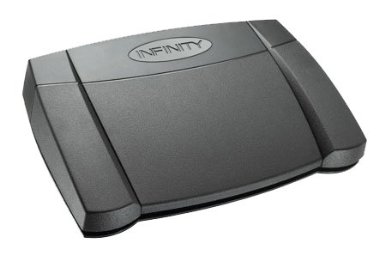UPDATE: I have subsequently found that transcribe works beautifully well and comes with some great pedal drivers. It’s a great piece of software and well worth the modest price. UPDATE 2: Please do not follow the instructions on this blog and expect them to work. It was written in 2013 so the software is *very* out of date and I doubt I’ll able to help you if it goes wrong.
John Heritage told me to go buy a foot pedal. I picked this Infinity USB-2 pedal up from ebay for $30.

It does make a tremendous difference not to have to constantly move one’s fingers from keyboard to mouse and back, although I had mitigated this considerably by using a thinkpad external keyboard with a trackpoint. However, this set-up did have some Rachmaninoff problems – requiring hand contortion to control audio, with attendant RSI/CTS-baiting effects that often resulted in sore wrists during transcription binges.
Getting the foot pedal working in Linux (Mint 14) was a minor mission, so I thought I’d document it for anyone else doing the same:
- First, I installed the lovely Footpedal GNOME integration control, which sadly seems a bit dormant.
- After installation, the script didn’t work immediately. I edited the script following Phillip Goodfellow’s instructions.
This involved:
a finding the script: # which footpedal —> /usr/bin/footpedal
b editing that script to comment out lines 119-126:
119 # Check whether your notification agent support
120 # icon-summary-body layout.
(...)
125 # self.reusable_notification.set_timeout(1000)
126 # Doesn't do anything
- Finally, after I got permissions issues (the error message suggested I run
sudo chmod a+r /dev/usb/hiddev0 footpedal, which didn’t seem to work) I followed Jason Barnett’s and Richard Steffan’s advice and set up a udev rule:
# /etc/udev/rules.d/footpedal.rules
#
# Set permissions for USB footpedal Infinity IN-USB-1
#
# sudo lsusb -v reports
# Bus 002 Device 002: ID 05f3:00ff PI Engineering, Inc.
# Device Descriptor:
# <...>
# idVendor 0x05f3 PI Engineering, Inc.
# idProduct 0x00ff
# bcdDevice 1.20
# iManufacturer 1 VEC
# iProduct 2 VEC USB Footpedal
#
# Rules recommended by PLUG mailing list member, Jason Barnett on
September 20, 2011
#
# After changing rules issue this command: sudo service udev restart
#
SUBSYSTEM=="usb", SYSFS{idVendor}=="05f3", MODE="0666"
SUBSYSTEM=="usb", ATTRS{idVendor}=="05f3", MODE="0666"
One sudo service udev restart later, and the footpedal is up and running! Now to get it working with CLAN under windows emulation…
